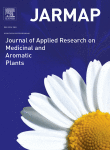Ver ítem
- xmlui.general.dspace_homeCentros Regionales y EEAsCentro Regional Patagonia NorteEEA BarilocheArtículos científicosxmlui.ArtifactBrowser.ItemViewer.trail
- Inicio
- Centros Regionales y EEAs
- Centro Regional Patagonia Norte
- EEA Bariloche
- Artículos científicos
- Ver ítem
Maqui (Aristotelia chilensis [Mol.] Stuntz) morphological and phenolic traits associated with forests type and latitudinal gradient in natural populations of Patagonia Argentina
Resumen
Maqui (Aristotelia chilensis [Mol.] Stuntz) is a native berry of the Patagonia Andean forests, which has one of the highest antioxidant levels currently known. This biochemical characteristic strongly depends on the phenolic profile and is highly influenced by the growing environment. The objective of this study was to characterize natural maqui populations in the immediate lee (Argentina) of the Northern Patagonian Andes, distributed in a latitudinal
[ver mas...]
Maqui (Aristotelia chilensis [Mol.] Stuntz) is a native berry of the Patagonia Andean forests, which has one of the highest antioxidant levels currently known. This biochemical characteristic strongly depends on the phenolic profile and is highly influenced by the growing environment. The objective of this study was to characterize natural maqui populations in the immediate lee (Argentina) of the Northern Patagonian Andes, distributed in a latitudinal gradient and associated with coihue (Nothofagus dombeyi) and cypress (Austrocedrus chilensis) forests, humid and xeric environments, respectively. Twenty-five natural populations that spanned the geographical distribution of the species in Argentina, were identified. The sites were associated with two forests (coihue and
cypress) and three latitudinal groups (north, center and south). Canopy cover and light interception were measured in the selected sites, as well as plant morphology, fruit yield components, phenolic profiles and oxygen radical absorbance capacity (ORAC) of mature berries. Maqui populations associated to cypress are exposed to greater incident total solar radiation and lesser rainfalls, and showed shorter plants with several main stems, multiple branching and smaller specific leaf area (SLA) as compared to those of coihue forest. Maqui populations associated to coihue presented an increase in the number of berries per bunch, and also in the accumulation of
phenols and ORAC. The evaluation of the acclimation responses of the natural populations by different environments can contribute to the development of high-yield and quality maqui crops as source of bioactive compounds.
[Cerrar]

Autor
Roldan, Cecilia Soledad;
Caballe, Gonzalo;
Fontana, Ariel;
Viale, Maximiliano;
Berli, Federico Javier;
Fuente
Journal of Applied Research on Medicinal and Aromatic Plants 25 : Art. 100341 (Diciembre 2021)
Fecha
2021-12
Editorial
Elsevier
ISSN
2214-7861
Formato
pdf
Tipo de documento
artículo
Palabras Claves
Derechos de acceso
Restringido
 Excepto donde se diga explicitamente, este item se publica bajo la siguiente descripción: Creative Commons Attribution-NonCommercial-ShareAlike 2.5 Unported (CC BY-NC-SA 2.5)
Excepto donde se diga explicitamente, este item se publica bajo la siguiente descripción: Creative Commons Attribution-NonCommercial-ShareAlike 2.5 Unported (CC BY-NC-SA 2.5)

